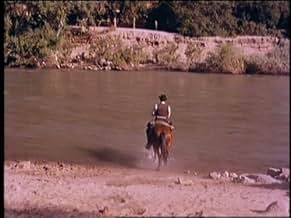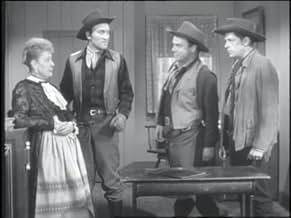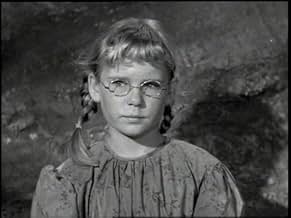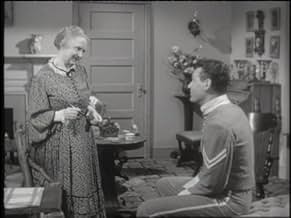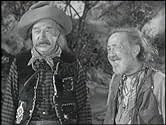As aventuras do herói mascarado e seu companheiro indígena americano.As aventuras do herói mascarado e seu companheiro indígena americano.As aventuras do herói mascarado e seu companheiro indígena americano.
- Indicado para 2 Primetime Emmys
- 3 indicações no total
Explorar episódios
Avaliações em destaque
Looking back on `The Lone Ranger' TV series as an adult is a strange experience. Watching episodes through an adult's eyes alerted me to flaws I didn't notice when I was a kid: the acting was sometimes on the B-movie level. The stories tended to be repetitive and simplistic. The Native Americans were generally played by Caucasian or Hispanic or Italian-American actors. The `outdoor' exteriors in a lot of episodes were obviously indoor sets. But there is a spirit and an energy to the show that you can't deny.
Most of the credit for the show's success goes to its leads, Clayton Moore and Jay Silverheels. They became the Lone Ranger and Tonto, lived the roles as no other actors before or since. Moore, in particular, knew the Ranger was presented as a hero and an example to children, and from what I've heard, he tried his best to live up to that. He made the Ranger a fair and just man, someone who didn't judge, who gave people the benefit of the doubt, but acted correctly when the time was right. He used violence only as a last resort. He was a symbol of honor and integrity, the kind of person I wish I could be.
As for Tonto... It occurs to me nowadays how great an actor Jay Silverheels was. Critics of the show always want to use Tonto as the stereotypical ignorant savage, but you have to look at all the things Tonto does. Tonto tracks, takes care of the Ranger when he's wounded, spies out information - you can tell from the expressions on Silverheels' face that there's a lot more going on inside Tonto's head than he lets on. Don't let the broken English fool you!
The thing that really impresses me about `The Lone Ranger' now is how much of a partnership these two characters have. Tonto is not the Ranger's subordinate - they are friends, equals in their adventures. That, as much as any lesson taught in any episode, is what draws me back to the series after so many years: a tried and true friendship.
Oh, if only the Lone Ranger could ride again.
Most of the credit for the show's success goes to its leads, Clayton Moore and Jay Silverheels. They became the Lone Ranger and Tonto, lived the roles as no other actors before or since. Moore, in particular, knew the Ranger was presented as a hero and an example to children, and from what I've heard, he tried his best to live up to that. He made the Ranger a fair and just man, someone who didn't judge, who gave people the benefit of the doubt, but acted correctly when the time was right. He used violence only as a last resort. He was a symbol of honor and integrity, the kind of person I wish I could be.
As for Tonto... It occurs to me nowadays how great an actor Jay Silverheels was. Critics of the show always want to use Tonto as the stereotypical ignorant savage, but you have to look at all the things Tonto does. Tonto tracks, takes care of the Ranger when he's wounded, spies out information - you can tell from the expressions on Silverheels' face that there's a lot more going on inside Tonto's head than he lets on. Don't let the broken English fool you!
The thing that really impresses me about `The Lone Ranger' now is how much of a partnership these two characters have. Tonto is not the Ranger's subordinate - they are friends, equals in their adventures. That, as much as any lesson taught in any episode, is what draws me back to the series after so many years: a tried and true friendship.
Oh, if only the Lone Ranger could ride again.
Someone once defined what is the definition of AN INTELLECTUAL as being: "A person who can listen to "The William Tell Overture" without thinking of the LONE RANGER!" In this, we heartily concur! It surely would be a tall order to accomplish this, and one that Leopold Stokowski, Arturo Toscanini or .Leonard Bernstein would all find nigh well impossible to do.
And in this there is no disgrace. The Radio Series and the Television Series, along with some Movie Serials, Feature Films, Syndicated Newspaper Comic Strip and Comic Books, all did their part to make "the Masked Man of the Plains and his Faithful Indian companion, Tonto" a deeply seeded element of our collective psyche and of our literary folklore.
As with most legends, it all started gradually, first with a series of Radio Plays, written for local use in Detroit over Radio Station WXYZ. The Creator was one George W. Trendle and the Principal Writer on the Series was Mr. Trendle's brother-in-law, Mr. Fran Striker. The year was 1933 when the Ranger first rode out to " the Plains of the Early Western United States!" The Lone Ranger, Tonto and the Radio Series all successfully guided Depression Era Americans through the mid and late '30's up to and through World War II. But the Post-War Era found the country in the midst of a Super-Nova Explosion of invention and technology. There had been a new communications medium standing ready in the wings, but unable to go forth until both VE Day and VJ Day had been achieved. Once these were accomplished and the World and America was ready to settle down to both Peace and Prosperity. The "New Technology" was, of course was TELEVISION! And we would surely need something else than "Roller Derby" and "Wrestling From Marigold Arena" to fill up the broadcast hours. And while at first, the time that a TV Station had anything on, except that portrait of that Mohican Chief (Test Pattern, Schultz!) Very soon and with post haste, the Networks began tapping their existing Natural Resources, their existing programming! Virtually all would be ripe for adaptation to the TV Screen.
So, the folks over at Lone Ranger, Incorporated were very interested when Producers Jack Chertok, Harry Poppe, Sherman Harris and Jack Wrather all approached them with a deal to put The Masked Man and Tonto on the Television waves, as well as the Radio.
Immediately they went to work and gave us the first season, which made use of the considerable back log of Radio Dramas, all potentially adaptable to TV dramas. They cast Clayton Moore, a fine supporting actor in many a feature film, and with about a dozen years experience. He also had done some work in Serials over at Republic Pictures' "Thrill Factory", which would be invaluable experience in doing "THE LONE RANGER". Cast as his "faithful Indian companion" and partner in bringing Justice to various parts of the Frontier, we had sheer perfection in character-supporting Actor, Jay Silverheels.** We must mention that there was that rift in about '53, when Clayton Moore walked and was replaced with John Hart. After a season or so, Mr. Moore was back in-having been missed so much! Now, Back to Our Story!! The first years of filming gave the episodes a look and a sound all of their own. They made good use of off screen Narrator, which gave these shows a feel of authenticity and an individual, stand-out one of a kind series. The actors employed were all veterans of the movies of the late silent era thru the 1930's and 1940's. A lot of them had been just about exclusively "Cowboy Movie" players. A good example of these is the casting of Glenn Strange (Bartender Sam on "GUNSMOKE") as the vicious, murderous Gang Leader, Butch Cavandish. And it was the Cavendish Gang's massacre of the Texas Rangers that led to the origin of John Reid (thought to have been slain with the other Texas Rangers) as the "LONE RANGER".
In addition to the old timers in the cast, you will find a lot of new and up and coming talent (then) in the cast. We see people like Phyllis Coates, Dwayne Hickman, Denver Pyle and others in the cast from week to week. All of this, along with an always calling for fair-play, justice and peace in a western world.
The last couple of seasons brought some big changes. First was the use of Colour Filming. That made no difference as a Colour TV Set was still a long way off for our household. The second was a new set of musical themes and queues. (Other than Rossini's Finale from "U NO Wutt!") The new music was never a big deal to us, as we preferred the "old Radio" stock stuff.
With this series and two Feature Films done during this period, THE LONE RANGER (Warner Brothers, 1956) and THE LONE RANGER AND THE LOST CITY OF GOLD (United Artists, 1958), the character has been permanently and indelibly impressed in our identity as a People, we Americans!
And in this there is no disgrace. The Radio Series and the Television Series, along with some Movie Serials, Feature Films, Syndicated Newspaper Comic Strip and Comic Books, all did their part to make "the Masked Man of the Plains and his Faithful Indian companion, Tonto" a deeply seeded element of our collective psyche and of our literary folklore.
As with most legends, it all started gradually, first with a series of Radio Plays, written for local use in Detroit over Radio Station WXYZ. The Creator was one George W. Trendle and the Principal Writer on the Series was Mr. Trendle's brother-in-law, Mr. Fran Striker. The year was 1933 when the Ranger first rode out to " the Plains of the Early Western United States!" The Lone Ranger, Tonto and the Radio Series all successfully guided Depression Era Americans through the mid and late '30's up to and through World War II. But the Post-War Era found the country in the midst of a Super-Nova Explosion of invention and technology. There had been a new communications medium standing ready in the wings, but unable to go forth until both VE Day and VJ Day had been achieved. Once these were accomplished and the World and America was ready to settle down to both Peace and Prosperity. The "New Technology" was, of course was TELEVISION! And we would surely need something else than "Roller Derby" and "Wrestling From Marigold Arena" to fill up the broadcast hours. And while at first, the time that a TV Station had anything on, except that portrait of that Mohican Chief (Test Pattern, Schultz!) Very soon and with post haste, the Networks began tapping their existing Natural Resources, their existing programming! Virtually all would be ripe for adaptation to the TV Screen.
So, the folks over at Lone Ranger, Incorporated were very interested when Producers Jack Chertok, Harry Poppe, Sherman Harris and Jack Wrather all approached them with a deal to put The Masked Man and Tonto on the Television waves, as well as the Radio.
Immediately they went to work and gave us the first season, which made use of the considerable back log of Radio Dramas, all potentially adaptable to TV dramas. They cast Clayton Moore, a fine supporting actor in many a feature film, and with about a dozen years experience. He also had done some work in Serials over at Republic Pictures' "Thrill Factory", which would be invaluable experience in doing "THE LONE RANGER". Cast as his "faithful Indian companion" and partner in bringing Justice to various parts of the Frontier, we had sheer perfection in character-supporting Actor, Jay Silverheels.** We must mention that there was that rift in about '53, when Clayton Moore walked and was replaced with John Hart. After a season or so, Mr. Moore was back in-having been missed so much! Now, Back to Our Story!! The first years of filming gave the episodes a look and a sound all of their own. They made good use of off screen Narrator, which gave these shows a feel of authenticity and an individual, stand-out one of a kind series. The actors employed were all veterans of the movies of the late silent era thru the 1930's and 1940's. A lot of them had been just about exclusively "Cowboy Movie" players. A good example of these is the casting of Glenn Strange (Bartender Sam on "GUNSMOKE") as the vicious, murderous Gang Leader, Butch Cavandish. And it was the Cavendish Gang's massacre of the Texas Rangers that led to the origin of John Reid (thought to have been slain with the other Texas Rangers) as the "LONE RANGER".
In addition to the old timers in the cast, you will find a lot of new and up and coming talent (then) in the cast. We see people like Phyllis Coates, Dwayne Hickman, Denver Pyle and others in the cast from week to week. All of this, along with an always calling for fair-play, justice and peace in a western world.
The last couple of seasons brought some big changes. First was the use of Colour Filming. That made no difference as a Colour TV Set was still a long way off for our household. The second was a new set of musical themes and queues. (Other than Rossini's Finale from "U NO Wutt!") The new music was never a big deal to us, as we preferred the "old Radio" stock stuff.
With this series and two Feature Films done during this period, THE LONE RANGER (Warner Brothers, 1956) and THE LONE RANGER AND THE LOST CITY OF GOLD (United Artists, 1958), the character has been permanently and indelibly impressed in our identity as a People, we Americans!
10hnsum7
There is only one Lone Ranger and only one Tonto. Clayton Moore and Jay Silverheels. They were both so ingrained in my childhood psyche as hero's, that they remain to this day to be just that. I have watched each and every episode, or at least I believe I have. In doing so it occurred to me that there was never really a gray area, there was right and there was wrong. There was good and there was evil...justice and injustice. Simple, yet powerful messages.
As an adult and watching the earliest episodes, it occurred to me that Tonto, actually gave all the idea's for his partners image. It was Tonto that suggested the mask. It was Tonto that suggested the silver bullets, and it was Tonto that came up with the name for Silver..when he proclaimed that the horse the Lone Ranger saved from death was "Silver White"! At last, as Tonto stood with the lone surviving Ranger over the graves of the others, Tonto, proclaimed "You are all alone now..You Lone Ranger! Of course, the response was "Yes Tonto, I am..The Lone Ranger!
The bonds of friendship and trust for the Lone Ranger and Tonto, was used 25 years later as an example of true friendship in an episode of Happy Days. In this particular episode, where Ritchie wanted to expose Fonzie for hating liver. The remark from Fonzie that typified what a true friendship should be was this "Many people tried to remove the mask of the Lone Ranger, but Tonto "never tried". All of America knew and felt that the truest of friendships would be to be like The Lone Ranger and Tonto.
Clayton Moore and Jay Silverheels are beloved for more than just being actors in a great western that will live forever. They are symbolic of so much more and as I said..will always be my hero's.
As an adult and watching the earliest episodes, it occurred to me that Tonto, actually gave all the idea's for his partners image. It was Tonto that suggested the mask. It was Tonto that suggested the silver bullets, and it was Tonto that came up with the name for Silver..when he proclaimed that the horse the Lone Ranger saved from death was "Silver White"! At last, as Tonto stood with the lone surviving Ranger over the graves of the others, Tonto, proclaimed "You are all alone now..You Lone Ranger! Of course, the response was "Yes Tonto, I am..The Lone Ranger!
The bonds of friendship and trust for the Lone Ranger and Tonto, was used 25 years later as an example of true friendship in an episode of Happy Days. In this particular episode, where Ritchie wanted to expose Fonzie for hating liver. The remark from Fonzie that typified what a true friendship should be was this "Many people tried to remove the mask of the Lone Ranger, but Tonto "never tried". All of America knew and felt that the truest of friendships would be to be like The Lone Ranger and Tonto.
Clayton Moore and Jay Silverheels are beloved for more than just being actors in a great western that will live forever. They are symbolic of so much more and as I said..will always be my hero's.
The 221 episodes of "The Lone Ranger" were originally broadcast on ABC from 1949 to 1957; and then for many years they played in local syndication. For most of the original broadcast years the series was ABC's most watched piece of programming.
The new DVD set from Pop Flix contains the first 16 episodes (15 Sept-29 Dec 1949) and for some reason unknown to me episode 22 from the fifth season, for a total of 17 episodes (the same 17 available on last year's Mill Creek Entertainment release so these are probably in the public domain). These sets pretty much render "The Legend of the Lone Ranger" movie superfluous as all three episodes that were combined in 1952 to form the movie are included in these releases.
The early episodes hark back to radio as there is considerably more voice-over narration used as an introduction and to introduce key plot moments.
The series itself was pure kiddie western with clear-cut good and evil distinctions and no romance. The title character (played by Clayton Moore) started out Texas Ranger John Reid. The first three episodes provide the background for his transformation to Lone Ranger status, his partnering with the Indian Tonto (Jay Silverheels), and the taming of his horse "Silver".
There is an unambiguous code of positive morality infusing each episode. The Lone Ranger is totally good but he adopts the guise of evil. While a masked man in the west was normally feared by the good citizens and an Indian was distrusted, the Lone Ranger is feared by those who would do evil. One persistent theme is that when the Lone Ranger and Tonto first encounter an average citizen they are greeted with suspicion, and by the end of the episode the citizen has been convinced of their value. The trademark ending was a secondary character asking the question: "who was that masked man?".
To really enjoy the series you must accept it for the simplistic morality tale it was intended to be. If you don't take it seriously and keep wishing for some self-reflexive campy parody elements you will only get frustrated.
Then again, what do I know? I'm only a child.
The new DVD set from Pop Flix contains the first 16 episodes (15 Sept-29 Dec 1949) and for some reason unknown to me episode 22 from the fifth season, for a total of 17 episodes (the same 17 available on last year's Mill Creek Entertainment release so these are probably in the public domain). These sets pretty much render "The Legend of the Lone Ranger" movie superfluous as all three episodes that were combined in 1952 to form the movie are included in these releases.
The early episodes hark back to radio as there is considerably more voice-over narration used as an introduction and to introduce key plot moments.
The series itself was pure kiddie western with clear-cut good and evil distinctions and no romance. The title character (played by Clayton Moore) started out Texas Ranger John Reid. The first three episodes provide the background for his transformation to Lone Ranger status, his partnering with the Indian Tonto (Jay Silverheels), and the taming of his horse "Silver".
There is an unambiguous code of positive morality infusing each episode. The Lone Ranger is totally good but he adopts the guise of evil. While a masked man in the west was normally feared by the good citizens and an Indian was distrusted, the Lone Ranger is feared by those who would do evil. One persistent theme is that when the Lone Ranger and Tonto first encounter an average citizen they are greeted with suspicion, and by the end of the episode the citizen has been convinced of their value. The trademark ending was a secondary character asking the question: "who was that masked man?".
To really enjoy the series you must accept it for the simplistic morality tale it was intended to be. If you don't take it seriously and keep wishing for some self-reflexive campy parody elements you will only get frustrated.
Then again, what do I know? I'm only a child.
Return with me now to those thrilling days of yesteryear.....
There can be no denying that The Lone Ranger is the quintessential TV Western of the 1950s. It is the one show that has proved, time and again, to be a real favorite of both children and adults alike.
Starring Clayton Moore, as the masked rider, and Jay Silverheels, as Tonto, his ever-loyal sidekick, The Lone Ranger was an action-packed, half-hour program whose episodes always had an interesting and thoughtful story to tell about life in the days of the Old West.
Actor Clayton Moore was the absolute embodiment of this mysterious, masked crime-fighter who would often go to great lengths to see that justice was done and that the criminals paid a dear price for their dishonest deeds.
Clayton Moore was once quoted as saying that he had "fallen in love with being the Lone Ranger character".
The Lone Ranger's story concerns a nameless Texas Ranger who is the sole survivor of a vicious ambush. After he is nursed back to health by his new-found comrade, Tonto, he embarks on a mission to bring justice and peace to the lawlessness of the Old West.
Using the benefits from a secret silver mine, the Lone Ranger rides the West on his magnificent horse, Silver, and dispenses justice in the form of his trademark - The silver bullet.
Following the cancellation of The Lone Ranger in 1957, Clayton Moore then embarked on a 40-year career making personal appearances, TV guest spots, and classic TV commercials dressed up as the legendary masked man.
In 1999 Moore died of a heart attack. He was 85 years old.
There can be no denying that The Lone Ranger is the quintessential TV Western of the 1950s. It is the one show that has proved, time and again, to be a real favorite of both children and adults alike.
Starring Clayton Moore, as the masked rider, and Jay Silverheels, as Tonto, his ever-loyal sidekick, The Lone Ranger was an action-packed, half-hour program whose episodes always had an interesting and thoughtful story to tell about life in the days of the Old West.
Actor Clayton Moore was the absolute embodiment of this mysterious, masked crime-fighter who would often go to great lengths to see that justice was done and that the criminals paid a dear price for their dishonest deeds.
Clayton Moore was once quoted as saying that he had "fallen in love with being the Lone Ranger character".
The Lone Ranger's story concerns a nameless Texas Ranger who is the sole survivor of a vicious ambush. After he is nursed back to health by his new-found comrade, Tonto, he embarks on a mission to bring justice and peace to the lawlessness of the Old West.
Using the benefits from a secret silver mine, the Lone Ranger rides the West on his magnificent horse, Silver, and dispenses justice in the form of his trademark - The silver bullet.
Following the cancellation of The Lone Ranger in 1957, Clayton Moore then embarked on a 40-year career making personal appearances, TV guest spots, and classic TV commercials dressed up as the legendary masked man.
In 1999 Moore died of a heart attack. He was 85 years old.
Você sabia?
- CuriosidadesThe Lone Ranger's young nephew, Dan Reid, who appeared occasionally on this show, was the father of Britt Reid, The Green Hornet. Both characters were created for radio by George W. Trendle.
- Erros de gravaçãoIn the series opening used in syndication, the Lone Ranger is seen riding past rows of trees planted as wind breaks. This practice did not come into use until after the "dust bowl" windstorms of the 1930s.
- Citações
[first lines for each episode]
Narrator: The Lone Ranger!
[gunshots are fired]
The Lone Ranger: Hi-yo, Silver!
Narrator: A fiery horse with the speed of light, a cloud of dust and a hearty "Hi-yo Silver" - the Lone Ranger!
The Lone Ranger: Hi-yo, Silver, away!
Narrator: With his faithful Indian companion, Tonto, the daring and resourceful masked rider of the plains led the fight for law and order in the early West. Return with us now to those thrilling days of yesteryear. The Lone Ranger rides again!
- Versões alternativasThe first three episodes are available edited together as a ersatz feature "Enter the Lone Ranger" (1949) running 68 minutes minus titles and recaps.
- ConexõesEdited into The Legend of the Lone Ranger (1952)
- Trilhas sonorasWilliam Tell Overture: Finale
(uncredited)
Written by Gioachino Rossini
[Played at program opening and during closing credits]
Principais escolhas
Faça login para avaliar e ver a lista de recomendações personalizadas
- How many seasons does The Lone Ranger have?Fornecido pela Alexa
Detalhes
- Data de lançamento
- País de origem
- Idioma
- Também conhecido como
- As Aventuras do Zorro, o Cavaleiro Solitário
- Locações de filme
- Empresas de produção
- Consulte mais créditos da empresa na IMDbPro
- Tempo de duração30 minutos
- Proporção
- 1.33 : 1
Contribua para esta página
Sugerir uma alteração ou adicionar conteúdo ausente




